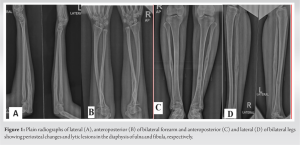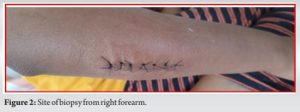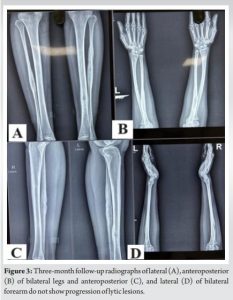Our case highlights uncommon manifestations of Klebsiella and the rarity of bilateral symmetrical multifocal osteomyelitis. In patients with sickle cell disease, heightened awareness of the potential for multifocal osteomyelitis is crucial, as illustrated in this clinical description.
Dr. Harsha Reddy, Department of Orthopedics, All India Institute of Medical Sciences, Nagpur, Maharashtra, India. E-mail: m.harshareddy1998@gmail.com
Introduction: Osteomyelitis is one of the most common infectious complications in people with sickle cell disease (SCD). The most common infecting organisms in SCD are the Salmonella species and Staphylococcus aureus; Streptococcus pneumoniae and Bacteroides species have also been described, however, osteomyelitis attributable to infection with hypervirulent Klebsiella spp. is a rare entity. We describe our experience with a rare presentation of multifocal bilateral symmetrical ulna and fibula osteomyelitis in a patient with SCD due to Klebsiella bacteremia with 1-year follow-up.
Case Report: A 25-year-old female known SCD since childhood who underwent treatment for dengue at our hospital had her blood cultures positive for Klebsiella, following which she was treated with appropriate antibiotics. Two weeks following the asymptomatic period patient presented with complaints of pain over the bilateral forearm and legs. The patient was evaluated for laboratory parameters and plain radiograph of the bilateral forearm and bilateral legs. The radiological features were suggestive of osteomyelitis, showing “Bilaterally symmetrical involvement.” Laboratory parameters erythrocyte sedimentation rate (ESR) and C-reactive protein (CRP) were found raised. The patient was planned for biopsy and debridement of the lesion from the right ulna. The culture from the biopsy showed growth of Klebsiella sp. and was sensitive to co-trimoxazole. The patient was started on co-trimoxazole for 6 weeks and had a significant clinical improvement in the form of subsidence of pain, normalization of the blood counts along with the acute phase reactants (ESR, CRP).
Conclusion: Our case contributes to the growing awareness of the unusual manifestations of this serious disease and the rarity of bilateral symmetrical involvement. Our case highlights the importance of clinician awareness, manifestations, and management of Klebsiella sp. hypervirulent strains.
Keywords: Sickle cell osteomyelitis, multifocal bilateral symmetrical, Klebsiella species.
Sickle cell disease (SCD) is the most commonly inherited hematological disorder, affecting millions of patients worldwide [1]. This condition produces abnormal hemoglobin, which leads to the “sickling” of red blood cells leading to vaso-occlusion. Because this commonly happens in the bones, patients with SCD are at an increased risk for orthopedic manifestations such as osteomyelitis, septic joint, or osteonecrosis. The increased propensity for osteomyelitis in SCD has been also attributed to functional asplenia and the presence of infarcted or necrotic bone [2, 3]. The most common infecting organisms are the capsulated bacteria such as Salmonella species, Staphylococcus aureus, Streptococcus pneumoniae, and Bacteroides species have also been described. However, Klebsiella has been reported as a new emerging organism [4]. Klebsiella sp. is a common pathogen responsible for infections such as urinary tract infections, community-acquired pneumonia, solid organ abscesses, as well as invasive infectious due to bacterial dissemination [4, 5]. Rarer complications include necrotizing fasciitis, osteomyelitis, and meningitis. Sturm et al. [5] described bilateral osteomyelitis and liver abscess caused by hypervirulent Klebsiella. Bilateral pyogenic osteomyelitis as a clinical entity is exceedingly rare as is long bone osteomyelitis attributable to infection with hypervirulent Klebsiella. We describe our experience of treating bilateral symmetrical ulna and fibula osteomyelitis.
A 25-year-old female health-care worker from central India, known SCD on folic acid and hydroxyurea, was admitted to our hospital 1 year back with complaints of fever and pain in the abdomen. She was diagnosed as a case of dengue, for which she was admitted under a physician. During the hospital course, her blood parameters revealed thrombocytopenia and blood culture showed growth of Klebsiella (all sickle cell patients are susceptible to capsulated organisms such as pneumococcus, Klebsiella, hemophilus due to functional asplenia, the patient did not receive any steroids during her hospitalization for dengue). She was then managed with a transfusion of platelets and blood products and was started on IV antibiotics injection Ceftriaxone + Tazobactam 8 hourly for 3 days, following which she showed improvement and was shifted to, oral doses of Cefixime 200 mg + Dicloxacillin 500 mg that were given for a week and was discharged.
Following an asymptomatic period of 2 weeks, the patient presented with pain over the bilateral forearm and legs. On examination, there was local warmth and bony tenderness at the right forearm, no local discharging sinus, and no clinical evidence of a subcutaneous collection. On evaluation, the plain radiological features (Fig. 1) were suggestive of periosteal changes and lytic lesions-osteomyelitis, although, the uniqueness of presentation of her symptoms was “Multifocal Bilaterally symmetrical involvement.” Laboratory evaluations were remarkable for leukocytosis with a white blood cell count of 18.4 × 103 (6.0–17.5) and C‐reactive protein of 35 mg/dL.
Differential diagnosis of the presenting condition was:
- Chronic multifocal recurrent osteomyelitis (CMRO)
- Multifocal pyogenic osteomyelitis
- Vaso-occlusive crisis leading to multiple bone infarcts.
Further to confirm our diagnosis, the incisional bone biopsy by corticotomy and debridement of the lesion from the most symptomatic right forearm region (right ulna) (Fig. 2) was performed.

The culture of biopsy from right ulna showed the growth of Klebsiella sp. and was only sensitive to Co-trimoxazole. The patient was started on co-trimoxazole, and she tolerated well and had a significant clinical improvement in the form of subsidence of pain, normalization of the blood counts along with the acute phase reactants. The antibiotic treatment was continued for 6 weeks, the patient was observed closely post-hospitalization, continued to recover well, and completed her antibiotic course without any issues. She has not had any more recurrences of osteomyelitis or other serious infections till 1-year follow-up (Fig. 3 and 4).


Patients with SCD present with osteomyelitis in both acute and chronic stages. The natural history of SCD is characterized by chronic anemia that is accompanied by simple or complicated vaso-occlusive crises (VOCs) that can compromise prognosis and cause chronic, life-threatening complications. The high susceptibility of SCD to bacterial infections is known to be due to functional asplenia resulting and its associated genetic, immunological, and sometimes environmental factors [6]. Although, conventionally, Salmonella has been suggested as the most common organism associated with SCD patients, the emerging causative organisms are Klebsiella, Clostridium [7], S. aureus among others. In our patient, SCD would be the predisposing host factor for the hypervirulence of Klebsiella. Osteomyelitis is an extremely challenging diagnosis to make in patients with SCD due to overlapping clinical and laboratory manifestations with the more common VOC of the bone or bone infarction. A high level of technology is required to differentiate between bone infarction and osteomyelitis in people with SCD. Routine investigations involving radiographs are usually within normal limits or may show vague signs such as soft-tissue edema, periostitis, or osteopenia. The lytic changes suggestive of osteomyelitis usually lag at least 2 weeks behind the process of the infection on radiographs which may delay diagnosis and aggravate the clinical scenario. Alternatively, ultrasonography was an upcoming promising screening tool as it has the ability to show acute findings of extraosseous pathology and/or periosteal elevation in osteomyelitis at an earlier stage [8]. MRI is the imaging modality of choice for the diagnosis of osteomyelitis and shows marrow edema typically presents as a localized marrow abnormality of decreased signal on T1-weighted images and increased signal on T2-weighted images [9]. The most acute finding of osteomyelitis on MRI is bone marrow edema or indirect findings of osteomyelitis such as soft-tissue collections, cellulitis, and cortical bone sinus tracts. PET‐CT helps in identifying additional foci of osteomyelitis. The bone scan is useful in multifocal diseases in particular, because easy to scan the whole body. However, the gold standard tool remains tissue biopsy and culture [9, 10]. The possibility of multifocal osteomyelitis was initially raised in this case based on the clinical history of preceding constitutional symptoms and the imaging findings. Other potential differential diagnoses include vaso-occlusive crises resulting in multiple bone infarcts, which can be distinguished through biopsy [10], and CMRO, a rare non-infective inflammatory disorder that mimics the pain associated with osteomyelitis [11]. We have reported this case owing to the rarity of its “Multifocal Bilaterally symmetrical” presentation due to bacterial seedings of bones at multiple sites that may have been traumatized in the course of SCD. Early diagnosis with biopsy and culture and prompt treatment with appropriated culture-sensitivity antibiotics helped in the faster recovery of our patient.
In an increasingly globalized world, our case highlights the importance of clinician awareness of the manifestations and management of Klebsiella sp. hypervirulent strains. The possibility of multifocal involvement should be kept in mind, based on the clinical history and preceding constitutional symptoms. These strains pose a substantial threat to human health because they have the potential to cause invasive and severe diseases, are highly transmissible, and are difficult to treat.
This case report presents multifocal osteomyelitis with bilateral symmetrical involvement due to post-viral illness bacteremia. Our case presents unusual manifestations of Klebsiella sp. and a rarity of bilateral symmetrical involvement. In patients with SCD, we must be more cognizant of the possibility of multifocal osteomyelitis. This clinical description narrates the same.
References
- 1.AlDallal SM. Osteomyelitis: A manifestation of sickle cell anemia. Clin Med Invest 2017;2(3):1-3 [Google Scholar]
- 2.Epps CH Jr., Bryant DD 3rd, Coles MJ, Castro O. Osteomyelitis in patients who have sickle-cell disease. Diagnosis and management. J Bone Joint Surg Am 1991;73:1281-94. [Google Scholar]
- 3.Scruggs M, Pateva I. Multifocal osteomyelitis in a child with sickle cell disease and review of the literature regarding best diagnostic approach. Clin Case Rep 2023;11:e7288. [Google Scholar]
- 4.Yu VL, Hansen DS, Ko WC, Sagnimeni A, Klugman KP, Von Gottberg A, et al. Virulence characteristics of Klebsiella and clinical manifestations of K. pneumoniae bloodstream infections. Emerg Infect Dis 2007;13:986-93. [Google Scholar]
- 5.Sturm E, Tai A, Lin B, Kwong J, Athan E, Howden BP, et al. Bilateral osteomyelitis and liver abscess caused by hypervirulent Klebsiella pneumoniae-a rare clinical manifestation (case report). BMC Infect Dis 2018;18:380. [Google Scholar]
- 6.Délicat-Loembet LM, Baraïka MA, Bougoudogo F, Diallo DA. Bacterial infection in the sickle cell population: Development and enabling factors. Microorganisms 2023;11:859. [Google Scholar]
- 7.Al-Tawfiq JA, Babiker MM. Multi-focal Clostridioides (Clostridium) Difficile osteomyelitis in a patient with sickle cell anemia: Case presentation and literature review. Diagn Microbiol Infect Dis 2020;96:114915. [Google Scholar]
- 8.Al Farii H, Zhou S, Albers A. Management of osteomyelitis in sickle cell disease: Review article. J Am Acad Orthop Surg Glob Res Rev 2020;4:e20.00002-10. [Google Scholar]
- 9.Lin B, Guo Q, Ren H, Liu Y, Huang K. MRI manifestations and diagnostic value of chronic osteomyelitis. J Healthc Eng 2021;2021:5585676. Retraction in: J Healthc Eng 2023;2023:9806362. [Google Scholar]
- 10.Wong AL, Sakamoto KM, Johnson EE. Differentiating osteomyelitis from bone infarction in sickle cell disease. Pediatr Emerg Care 2001;17:60-3, quiz 64. [Google Scholar]
- 11.Zhao DY, McCann L, Hahn G, Hedrich CM. Chronic nonbacterial osteomyelitis (CNO) and chronic recurrent multifocal osteomyelitis (CRMO). J Transl Autoimmun 2021;4:100095. [Google Scholar]











